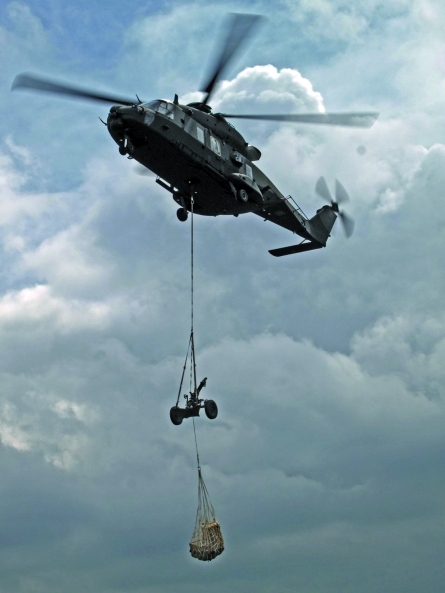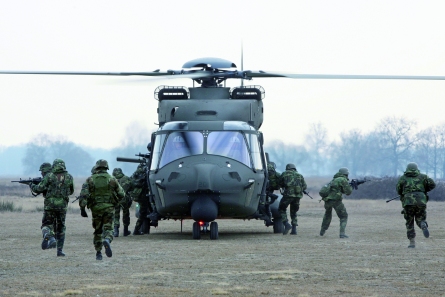The NH90 is set to be a mainstay for the Italian military, but while the army is about to get its first of 60 helicopters, the navy will have to wait
The Italian army will receive its first NH Industries NH90 tactical transport helicopter (TTH) in December after a delay of more than three years, while the nation's first naval frigate helicopter (NFH) variant of the aircraft is poised to complete its latest series of trials and evaluations in a bid to overcome weight and avionics problems before deliveries can start during 2009.
The NH90 project is the main helicopter acquisition for Italian army aviation, which will receive 60 of the aircraft to replace some of its Agusta-Bell AB205/212/412s. The new type will become the only utility helicopter of army aviation's main combat formation, the Friuli Airmobile Brigade.
"We are working to compress the deliveries to maintain the original replacement plan, which was to last until 2017," says army aviation commander Maj Gen Enzo Stefanini. In a move to compensate for the delivery delays, the army has sent a first cadre of crews and technicians for training with AgustaWestland, which will also establish support services for the new aircraft. Italy's third production TTH was deployed to the Viterbo army aviation training centre during March-April to accelerate preparations for operating the new type, he adds.
Ready for training
The army's first six NH90s will be delivered to Viterbo in an initial operational capability configuration, with initial software and mission equipment suitable for training purposes. "From spring 2008 we will receive six additional helicopters in an IOC-plus configuration for initial use, while full operational capability [FOC]-configuration helicopters will be handed over by early 2009," says Col Claudio Gasperini, head of new platforms and systems acquisition programmes at army aviation command.
IOC-plus platforms will be able to operate at ISA +35e_SDgrC (95°F), have a complete de-icing system for both their main and tail rotors and elevator, the potential to carry pintle-mounted Oto Melara 7.62mm M-134D Gatling guns and use their rear ramps, Gasperini says. The full operational standard will add two Selex Communications SRT-151P V/UHF radios with Saturn secure communications functionality, a Sicral satellite communications terminal and a new software release, while Selex Communications' LOAM obstacle warning system is also a growth target.
|
|---|
Italy's army will begin NH90 training next month |
Headquartered in Bologna and with combat regiment units based near Pordenone and Rimini, the Friuli Airmobile Brigade will receive all of the army's operational NH90s, except for the six that will be assigned to the Viterbo-based special operations group and later upgraded to a common FOC standard. "Despite more recent delays, Italian army aviation still plans to have the first squadron with six helicopters ready to be deployed abroad by the end of 2009," says Stefanini.
"The NH90 represents a huge improvement compared with the in-service transport and combat support rotary-wing fleet, in terms of capabilities, avionics and self-defence," says army aviation command programme head Lt Col Massimo Bonesi. "The fly-by-wire system allows very easy and smooth handling, depending on the selected ride-type, and substantially reduces pilot workload, meaning the crew can concentrate on mission accomplishment," he adds.
Army requirements
The army aircraft is required to take off from an altitude of 305ft (1,000m) at ISA +15e_SDgrC, carrying a crew of three plus 14 soldiers. It should conduct a 2h 30min transport mission over a radius of 455km (245nm) at a cruise speed of 140kt (260km/h) before performing a nap-of-the earth landing area approach in all weather conditions and by day or night.
Key mission equipment includes Thales helmet-mounted displays, a Galileo Avionica forward-looking infrared sensor, digital map generator, weather radar with limited ground mapping capabilities and a laser gyro/GPS navigation suite. The HMDs are equipped with binocular displays that can switch from night vision to FLIR imagery, with superimposed navigation and mission data via a push button on the collective, Bonesi says. The service will start taking delivery of an ElsagDatamat-produced mission planning system from late this year, with the system to comprise both fixed and mobile stations.
|
|---|
Weight and avionics problems on the naval variant will delay service entry until late 2009 |
For frontline operations, the TTH is the only Italian army aircraft apart from the AgustaWestland AW129 Mangusta attack helicopter to be equipped since its inception with self-defence equipment. This includes an electronic warfare suite with Thales threat-warning system, EADS/Selex Communications MILDS missile warning system, Selex Communications laser warning receiver and chaff and flare dispensers.
Army NH90s will operate with a crew of two pilots and one or two flight engineers, says Gasperini, although the aircraft is certificated to fly single-pilot missions. Nine instructor-pilots and around 50 flight engineers and technicians have already been trained using an evolving syllabus that at full strength will comprise ground classes using computer aids and part task trainers (PTT), before qualification and operational training totalling around 70 flight hours.
Cockpit arrangement
The service has not included a full-flight simulator as part of its training system, but Gasperini says: "The training centre is putting a lot of effort in a cost-effective evolution of the PTT into a cockpit arrangement to better replicate the real flight cabin. The PTT and flying mix is considered to more than satisfy the training needs."
To keep pace with the introduction of the new-generation helicopter, AgustaWestland has agreed a three-year support contract, under which it will guarantee 20 flight hours a month from each helicopter from first delivery, providing logistics support from technical centres in Rimini and Viterbo. "With this contract and the compressed delivery roadmap, we plan to progressively increase the flying personnel preparation through a stepped operational training syllabus," says Stefanini.
In addition to building TTH aircraft for Italy and Portugal, AgustaWestland is also leading the development and integration of the NFH naval variant and will assemble examples for the Dutch, Italian and Norwegian navies. The naval variant has also been ordered by France and selected by Germany.
|
|---|
The NH90 will become the only utility helicopter of army aviation's main combat formation, the Friuli Airmobile Brigade |
Designed to operate by day and night and in adverse weather conditions up to a ship deck motion of Sea State 6, the NFH version maintains a high degree of platform and core avionics commonality with the tactical transport.
But while the first series production aircraft for all customers are already under trial, "the unavailability of a production-representative platform for most of the earlier trials conducted with the single PT5 prototype, as well as airframe and avionics problems, have hampered the development and production of the NFH version", says Domenico Vaccari, vice-president of the NH90 programme.
Solutions
"However, solutions to most technical issues have already been identified, tested and applied, while others are showing encouraging results, with first deliveries planned for late 2009," he says. This process has included a successful July test of an undercarriage upgrade provided by Fokker Stork aboard the Italian navy Maestrale-class frigate Scirocco.
Platform weight issues, common to the TTH version, have also affected the naval aircraft. "To reduce the 400kg [880lb] weight increase on the naval version, we augmented the maximum gross weight from 10,600kg to 11,000kg, and augmented the engine and main rotor rpm," Vaccari says.
Ship trials will initially be conducted using a French Rolls-Royce/Turbomeca RTM322-01/9-powered NH90, and then from February 2009 by an Italian aircraft using General Electric/Avio T700/T6E1s, which will also equip the nation's TTH transports. "We are also working on a platform weight-reduction programme that is expected to produce a 120kg saving to be applied on first series production NFH90s."
The NFH has a Secondo Mona-produced fully automatic main rotor blade and tail-boom folding system, strengthened landing gear with steerable twin nosewheel, Magnaghi-supplied deck harpoon, deck traversing system interface, emergency flotation bags and a rescue winch. Its mission system has also been designed to perform anti-submarine warfare (ASW) and anti-surface warfare missions with a pilot and tactical co-ordinator in the cockpit and a sensor operator in the cabin.
Its avionics suite also differs from the TTH in having a dedicated tactical control system (TCS) that oversees communication, navigation and display subsystems, along with tactical database and mission sensors/subsystems management. However, drawing on its experience with the EH101, the navy has opted to add a second sensor operator and console to reduce crew workload.
The NFH cockpit has five 8 x 8in (200 x 200mm) displays - versus four in the TTH - and two control and display units to interact with the TCS, while the sensor consoles feature three multifunctional displays and sensor and system control units. The aircraft's avionics suite is supplied by Thales Avionics, with Diehl Aerospace, Galileo Avionica, Selex Communications' Sirio Panel company and Teldix.
The aircraft's primary surface search sensor is the European naval radar provided by prime contractor Galileo Avionica, EADS and Thales Avionics. "Pre-qualification system trials showed deficiencies which forced Thales to heavily intervene on both hardware and software," says Vaccari, who adds: "These activities are producing encouraging results." System qualification activities are expected to continue until mid-2008, he adds. The aircraft's tactical navigation package should also receive upgraded software within the same period.
The NFH's Elettronica DETE 90 electronic support measures system and Sagem FLIR sensor have already successfully completed system qualification flying trials, with the latter incorporating a thermal imager, TV camera and laser rangefinder. An enhanced version of the ESM system already installed on the Italian navy's proven AgustaWestland EH101s, the DETE 90 provides radar warning receivers, electronic intelligence capability and chaff and flare dispensers.
ASW suite
The standard ASW suite is based on the Galileo Avionica OTS-90 sonic system, which comprises L-3 Communications' low frequency helicopter long-range active dipping sonar, and a sonobuoy subsystem including a 10-station rotary dispenser provided by MES of Italy and a lightweight common acoustic processor. The NFH communication suite includes a Selex Communications Link 11 system.
The Italian navy is so far the main customer for the naval variant, having a requirement for 46 aircraft, as well as for 10 navalised TTH aircraft for amphibious and logistics support operations. "To become the backbone of the Italian navy rotary-wing fleet, the new platform will replace the AB-212ASW fleet. Deliveries will run from 2009 for the NFH90 version to 2016, when the navalised TTH batch will be introduced," says Rear Adm Giuseppe Cavo Dragone, head of Italian navy aviation.
Italian navy aircraft will also feature a range of external payloads, including Eurotorp MU90 torpedoes, MBDA Marte Mk2S anti-ship missiles and fuel tanks, while the type will also be fitted to carry 7.62mm Gatling guns.
|
|---|
ASW suite includes an active dipping sonar |
"Ship trials to determine the NFH90 flight envelope and shipborne operational limits will be carried out by the first quarter of next year," says Lt Giancarlo Ciappina, the service's programme manager for the aircraft. "The ASW suite successfully completed functional and performance systems evaluation campaigns this summer, and the Link 11 and satcom are also in an advanced stage," he adds.
"By 2008 we will begin crew and technician training at AgustaWestland facilities and Luni air station. A cadre of experienced EH101 pilots will transfer to the 5th Helicopter Group equipped with AB-212ASWs, to form the core of new NFH90 crews," says Ciappina, adding that other AB-212-equipped units at Grottaglie and Catania air stations will also later convert to the new type.
The navy will adopt a similar phased logistics support approach as contracted by the army, and also seek to host operational evaluation work for other NH90 customers, he says.
Source: Flight International



























